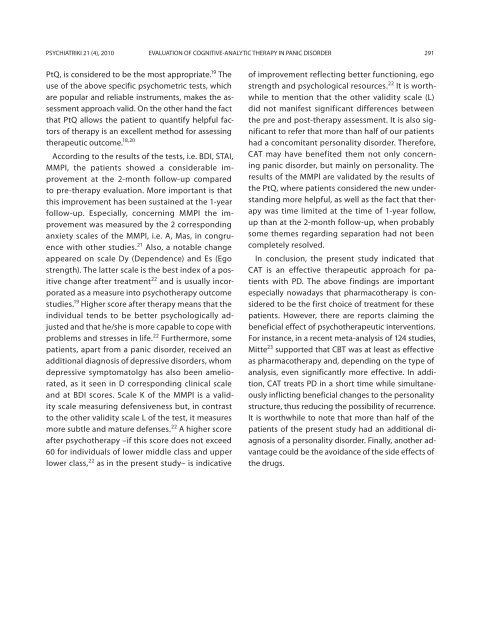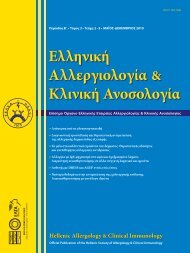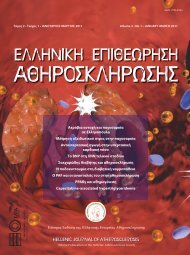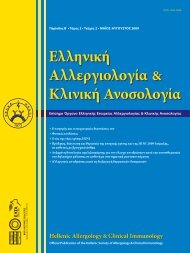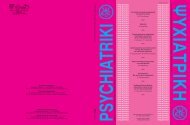ÏÏ ÏιαÏÏικη - ÎÎΤΠÎαÏÏικÎÏ ÎκδÏÏειÏ
ÏÏ ÏιαÏÏικη - ÎÎΤΠÎαÏÏικÎÏ ÎκδÏÏειÏ
ÏÏ ÏιαÏÏικη - ÎÎΤΠÎαÏÏικÎÏ ÎκδÏÏειÏ
- No tags were found...
You also want an ePaper? Increase the reach of your titles
YUMPU automatically turns print PDFs into web optimized ePapers that Google loves.
PSYCHIATRIKI 21 (4), 2010 EVALUATION OF COGNITIVE-ANALYTIC THERAPY IN PANIC DISORDER 291PtQ, is considered to be the most appropriate. 19 Theuse of the above specific psychometric tests, whichare popular and reliable instruments, makes the assessmentapproach valid. On the other hand the factthat PtQ allows the patient to quantify helpful factorsof therapy is an excellent method for assessingtherapeutic outcome. 18,20According to the results of the tests, i.e. BDI, STAI,MMPI, the patients showed a considerable improvementat the 2-month follow-up comparedto pre-therapy evaluation. More important is thatthis improvement has been sustained at the 1-yearfollow-up. Especially, concerning MMPI the improvementwas measured by the 2 correspondinganxiety scales of the MMPI, i.e. A, Mas, in congruencewith other studies. 21 Also, a notable changeappeared on scale Dy (Dependence) and Es (Egostrength). The latter scale is the best index of a positivechange after treatment 22 and is usually incorporatedas a measure into psychotherapy outcomestudies. 19 Higher score after therapy means that theindividual tends to be better psychologically adjustedand that he/she is more capable to cope withproblems and stresses in life. 22 Furthermore, somepatients, apart from a panic disorder, received anadditional diagnosis of depressive disorders, whomdepressive symptomatolgy has also been ameliorated,as it seen in D corresponding clinical scaleand at BDI scores. Scale K of the MMPI is a validityscale measuring defensiveness but, in contrastto the other validity scale L of the test, it measuresmore subtle and mature defenses. 22 A higher scoreafter psychotherapy –if this score does not exceed60 for individuals of lower middle class and upperlower class, 22 as in the present study– is indicativeof improvement reflecting better functioning, egostrength and psychological resources. 22 It is worthwhileto mention that the other validity scale (L)did not manifest significant differences betweenthe pre and post-therapy assessment. It is also significantto refer that more than half of our patientshad a concomitant personality disorder. Therefore,CAT may have benefited them not only concerningpanic disorder, but mainly on personality. Theresults of the MMPl are validated by the results ofthe PtQ, where patients considered the new understandingmore helpful, as well as the fact that therapywas time limited at the time of 1-year follow,up than at the 2-month follow-up, when probablysome themes regarding separation had not beencompletely resolved.In conclusion, the present study indicated thatCAT is an effective therapeutic approach for patientswith PD. The above findings are importantespecially nowadays that pharmacotherapy is consideredto be the first choice of treatment for thesepatients. However, there are reports claiming thebeneficial effect of psychotherapeutic interventions.For instance, in a recent meta-analysis of 124 studies,Mitte 23 supported that CBT was at least as effectiveas pharmacotherapy and, depending on the type ofanalysis, even significantly more effective. In addition,CAT treats PD in a short time while simultaneouslyinflicting beneficial changes to the personalitystructure, thus reducing the possibility of recurrence.It is worthwhile to note that more than half of thepatients of the present study had an additional diagnosisof a personality disorder. Finally, another advantagecould be the avoidance of the side effects ofthe drugs.


